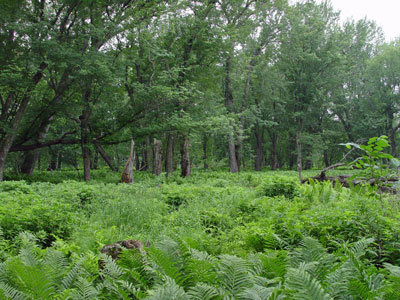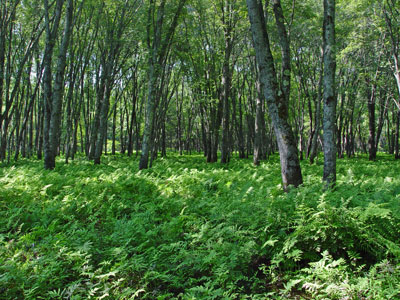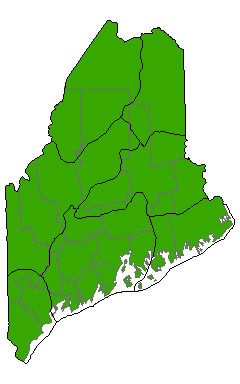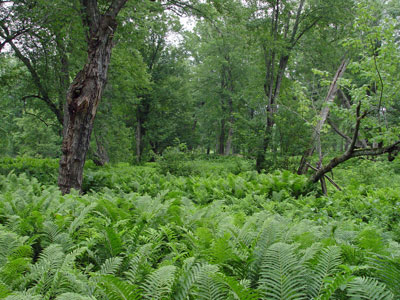DACF Home → Bureaus & Programs → Maine Natural Areas Program → Communities, Plants, and Animals → Natural Community Fact Sheets → Silver Maple Floodplain Forest
Printer Friendly Fact Sheet - 870 KB pdf (Get a free copy of Adobe Acrobat Reader)
Silver Maple Floodplain Forest
Scientific Name: Silver Maple Floodplain Forest; State Rank: S3

- Community Description
- Soil and Site Characteristics
- Diagnostics
- Similar Types
- Conservation, Wildlife and Management Considerations
- Distribution
- Characteristic Plants
- Associated Rare Plants
- Associated Rare Animals
- Examples on Conservation Lands You Can Visit
Community Description: These forests are dominated by silver maple (>60% cover). Associates include red maple and American elm (up to 30% cover) or, in a few locations, bur oak (up to 25% cover). Widely spaced trees, many with multiple trunks, give a park like feeling. The understory is open and shrubs are sparse. Musclewood may be present and is a good indicator. The lush carpet of herbs changes from spring ephemerals such as trout lilies and bloodroot to dense fern cover in summer. Bryoid cover is minor. Some forests have a berm adjacent to the river channel, and herbaceous species composition here is different from the lower elevation interior of the floodplain. Back to top.

Soil and Site Characteristics: Sites occur on plains flanking low gradient rivers, within the reach of seasonal floods, at elevations <700’. Soils are fine sand or silt, usually with good drainage capacity; the water table fluctuates. Relatively high nutrient levels result from sediment deposition of annual floods; pH is typically 5.0-6.2. Back to top.
Diagnostics: Sites occur in a floodplain setting with mineral soil. Silver maple is the dominant tree. There is a dense herb layer with sensitive fern and, locally, ostrich fern. Spring ephemerals are frequent. Back to top.
Similar Types: Upper Floodplain Hardwood Forests may be adjacent to this type on the higher floodplain, but these have a much smaller proportion of silver maple in the canopy. Instead, the canopy is dominated by sugar maple, red oak, or green ash, and herb diversity is higher. Red Maple Swamps lack the dominance of silver maple, and have surface water or saturated soil throughout the growing season. Hardwood Seepage Forests occur along small drainages, usually sloping, rather than in extensive floodplains. Back to top.
Conservation, Wildlife and Management Considerations: Although a number of sites have been cleared or pastured in the past, current shoreland regulations provide increased protection to a number of these sites. Exotic plant species such as Japanese knotweed, which may displace those native to our area, also represent a threat to the integrity of these forests and have degraded some Maine examples. Several of the known examples are formally protected from conversion.
Northern waterthrush, barred owl, belted kingfisher, bank swallow, and green heron are associates of this community type. In the southern part of the state, the Louisiana waterthrush and yellow-throated vireo are likely associates if the canopy is closed or nearly so. Rare turtles like wood, spotted, and Blanding’s turtles may feed on amphibian egg masses present in isolated pools within such forests. Wood turtles overwinter in river channels and forage in floodplain forests. The silver-haired bat often roosts in riparian habitats in trees with loose bark. Back to top.
Distribution: Long and narrow floodplains along the shores or islands of large rivers and streams throughout Maine, New England, and New Brunswick. Landscape Pattern: Large Patch (remaining sites mostly 20-200 acres, up to 1000 acres). Back to top.


Characteristic Plants: These plants are frequently found in this community type. Those with an asterisk are often diagnostic of this community.
- Canopy
- American elm
- Basswood*
- Black ash
- Black cherry*
- Bur oak*
- Green ash*
- Red oak*
- Silver maple*
- Sapling/shrub
- Arrowwood*
- Buttonbush*
- Common blackberry*
- Gray birch*
- Meadowsweet*
- Musclewood*
- Nannyberry*
- Winterberry holly*
- Dwarf Shrub
- Swamp dewberry*
- Herb
- Bluejoint
- Cinnamon fern*
- Green ash
- Jack-in-the-pulpit
- Ostrich fern*
- Royal fern*
- Sensitive fern*
- Tall meadow-rue
- Wood-nettle*
- Wood turtle
Examples on Conservation Lands You Can Visit
| Example | County |
|---|---|
| Brownfield Bog Wildlife Management Area | Oxford Co. |
| Saco River Preserve | York Co. |
| Sunkhaze Meadows National Wildlife Refuge | Penobscot Co. |
| The Oxbow, East Branch Penobscot River | Penobscot Co. |
| Trout Brook, Baxter State Park | Piscataquis Co. |
| Wassataquoik Public Lands | Penobscot Co. |
